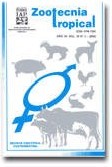
|
Zootecnia Tropical
Instituto Nacional de Investigaciones Agrícolas Venezuela
ISSN: 0798-7269
Vol. 23, No. 2, 2005, pp. 105-119
|
 Bioline Code: zt05009
Bioline Code: zt05009
Full paper language: English
Document type: Research Article
Document available free of charge
|
|
|
Zootecnia Tropical, Vol. 23, No. 2, 2005, pp. 105-119
| en |
Growth and bromatologic composition of hydroponic corn fodder in differents dates of harvest and sowing densities
Liziany Müller, Paulo A. Manfron, Osmar S. Santos, Sandro L. P. Medeiros, Valdecir Haut, Durval Dourado Neto, Evandro Binotto Fagan e Andrieli H. Bandeira
Abstract
The experiment was conducted inside a protected environment (tunnel) at Fitotecnia Department of the Universidade Federal of Santa Maria, RS, Brazil. This work aimed to evaluate the effect of different harvest dates and sowing densities in growth and bromatological composition of hydroponic corn fodder. It was utilized the randomized experimental design. Treatments consisted of four sowing densities (0.5, 1.0, 1.5 e 2.0 kg seed/m2) and two dates of harvests (10 and 20 days after germination) distributed in 4x2 factorial scheme. It was not observed interaction (P>0.05) between sowing densities and harvest date for all variables analyzed. Increment of sowing densities increased the values of crude protein and decreased the values of neutral and acid detergent fiber and lignin. The results indicates that the harvest at 10 days showed highest values (P<0.05) of crude protein and fresh biomass and lowest values of plant height, dry biomass, neutral detergent fiber and lignin. The best characteristics of hydroponic corn fodder were verified in 2.0 kg seed/m2 and harvest at 10 days after sowing.
Keywords
protected environment, hydroponic system, Zea mays
|
| |
| es |
Produção e composição bromatologica da forragem hidropônica de milho, Zea mays  L., com diferentes densidades de semeadura e datas de colheita L., com diferentes densidades de semeadura e datas de colheita
Liziany Müller, Paulo A. Manfron, Osmar S. Santos, Sandro L. P. Medeiros, Valdecir Haut, Durval Dourado Neto, Evandro Binotto Fagan e Andrieli H. Bandeira
Resumen
Foi realizado um experimento em ambiente protegido (túnel alto), no Departamento de Fitotecnia da Universidade Federal de Santa Maria, RS, Brasil, com objetivo de avaliar a produção e a composição bromatológica da forragem de milho produzida em hidroponia, identificando a densidade adequada de sementes e a data ideal de colheita. Adotou-se o delineamento experimental inteiramente casualizado e os tratamentos foram distribuídos em esquema fatorial 4x2, constituídos por quatro densidades de semeadura (0,5 1,0 1,5 e 2,0 kg m-2) e duas colheitas (10 e 20 dias). Não foi observada significância (P>0,05) à interação densidade de semeadura x data de colheita para todas as variáveis analisadas. O aumento da densidade de semeadura promoveu incremento no teor de proteína bruta e redução nos teores de fibra em detergente neutro, fibra em detergente ácido e lignina. A colheita aos 10 dias permitiu maiores valores (P<0,05) de fitomassa fresca e proteína bruta, e menores valores de estatura, fitomassa seca, fibra em detergente neutro e lignina. A forragem hidropônica de milho pode ser cultivada com densidade de semeadura de 2 kg m-2 e sua colheita podem ser realizadas aos 10 dias.
Palabras-clave
ambiente protegido, hidroponia, Zea mays.
|
| |
© Copyright 2005 - Zootecnia Tropical
Alternative site location: http://www.sian.inia.gob.ve/repositorio/revistas_ci/ZootecniaTropical/ztindice.htm
|
|
